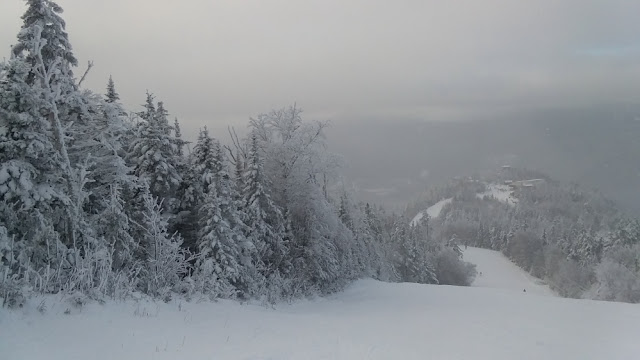 |
| Thursday, November 29. There is much more open water today. |
So we'll keep watching but we won't have a record ice-in this year.
If you didn't see the late edit to last week's post, the bears are back on the prowl. After snow and a few days of bitter cold I thought they might be off to bed for the winter, but on Sunday there were fresh tracks to be found, and more on Monday.
That track was made by a bear in its slow, alternating walking gait, with the footprints appearing pigeon toed as is usual. [Ref: "Tracking and the Art of Seeing", Paul Rezendes, HarperCollins, 1999] The prints are mostly direct-registered (meaning the larger hind foot falls directly on top of the smaller front footprint. The print at the far left shows where the hind foot just overstepped the front foot.
Bear tracks this clear are easily distinguishable, as they look a lot like human footprints.
They are almost the same size too.
So the birds will just have to wait a bit longer before the feeders go out - it's a benefit to have snow on the ground to make it clear when bears are active. And snow we have. The snow in the Lakes Region isn't suitable for skiing at this point, but a bit farther north it's a different story. The White Mountains received two feet of snow last week and the early skiing is the best ever.
 |
| Summit of Loon Ski Area on November 30th |
With the rapid onset of cold weather I didn't get to see many migratory birds - I think they took the non-stop flight from Canada to the coast this year. I saw a few mergansers early in November, a few other birds off in the distance, and then these two just before the cove iced over.
And that's about it. Though just few days ago a friend on Lake Waukewan saw a flock of 50 mergansers on Waukewan, all of them lined up in a row. (Thanks TS!)
 |
| Can you see the long line of ducks? Photo by Anthony Sabutis |
Here they are a little closer.
A year-round resident, and one of the most impressive in our region, also made an appearance this week. Even though it was far off in the distance, its size and distinctive wing pattern distinguished it as our largest raptor, the bald eagle.
 |
| Hiding from the wind behind Sheep Island |
I wonder if it's the same bird that another friend saw, this time on Wakondah Pond in Moultonborough. (Thanks SS!)
 |
| A better look at an eagle on the shore of Wakondah Pond (Photo by Suzanne Satnick) |
Even though I might see these impressive animals a few times over the course of a year, it's still rare enough that I'm always moved by the size and the self-assured demeanor of these birds which sit at the top of the food chain. They will rule the fishing on our lakes until they finally do freeze over.






No comments:
Post a Comment